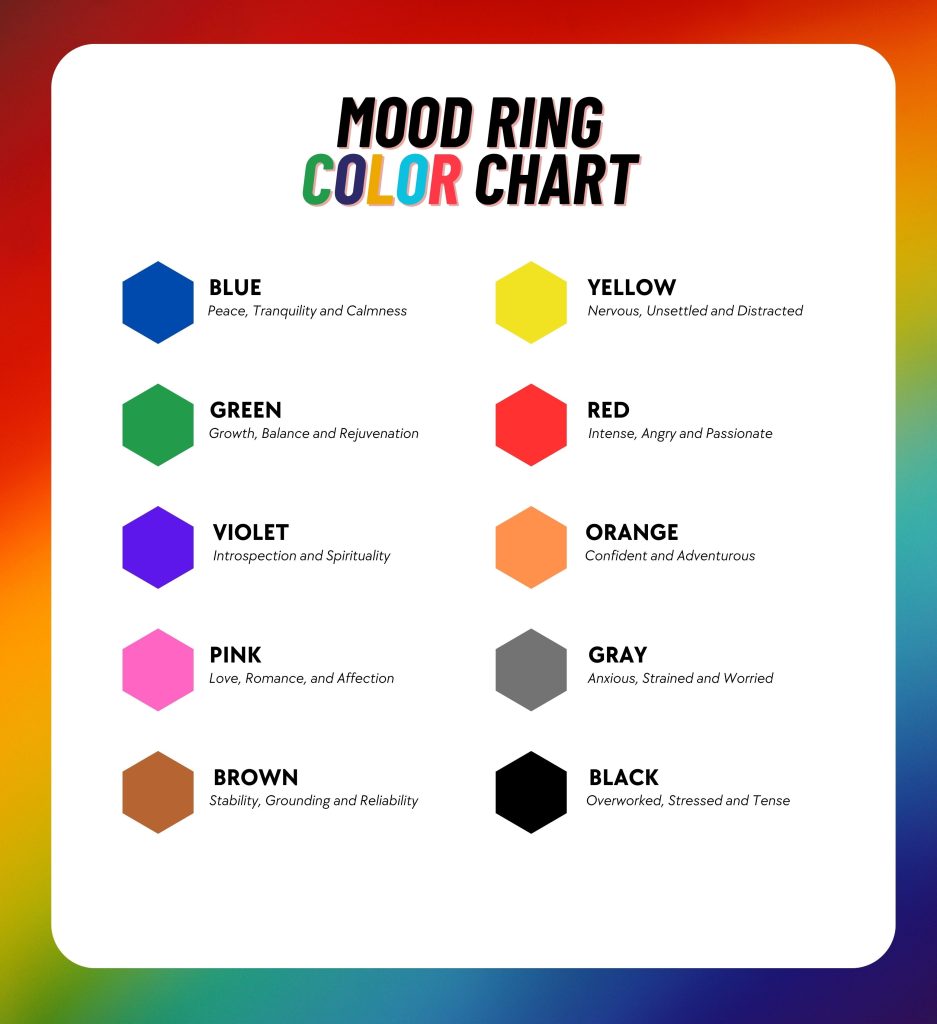A mood ring is a fascinating piece of jewelry that changes colors in response to the wearer’s body temperature and emotional state. Its main purpose is to provide insight into the wearer’s mood or emotional well-being.
The color changes in a mood ring are due to the thermochromic crystals present in the ring. These crystals are sensitive to temperature changes, and when they come into contact with the heat from the wearer’s body, they react by changing colors. This dynamic relationship between body temperature and the ring’s color is what gives a mood ring its unique and captivating quality.
Each color on a mood ring chart corresponds to a particular emotion or state of mind. For example, blue is often associated with a calm and relaxed feeling, while green represents balance and harmony. Warm colors like red and orange reflect passion and energy, whereas cooler colors like purple and blue symbolize tranquility and introspection. The absence of color or a black ring may indicate negative emotions or a state of being overwhelmed.
While mood rings may not have a scientific basis, many people enjoy using color psychology and metaphysical properties to interpret the color changes. This alternative approach allows individuals to gain a deeper understanding of their emotional state and potentially make positive changes in their lives.
A mood ring is an intriguing piece of jewelry that changes colors in response to the wearer’s body temperature and emotional state. It offers a unique way to interpret and understand one’s emotions through the language of color psychology and metaphysical properties.

How Does Colors In Mood Ring Work
Mood rings captivate us with their ability to change color, but have you ever wondered how they actually work? The secret lies within the presence of thermochromic crystals in the ring. These unique crystals have the fascinating ability to change color in response to temperature changes, creating the captivating effect we love.
But how exactly do these thermochromic crystals work? Well, it’s all about the orientation of liquid crystals within the ring. Liquid crystals have two phases: the nematic phase and the smectic phase. In the nematic phase, the liquid crystals align in a particular direction, causing the ring to appear a certain color. However, when temperature changes occur, the liquid crystals transition to the smectic phase, where their orientation changes. This alteration in orientation causes a shift in the color we see on the ring.
It’s important to note that temperature extremes can affect the crystals’ ability to change color. If the temperature gets too hot or too cold, the liquid crystals may not be able to transition between the nematic and smectic phases, resulting in a consistent color on the ring.
So, the next time you wear a mood ring, remember the marvel of thermochromic crystals and their reaction to your body’s temperature. It’s a beautiful and intricate process that adds a touch of magic to this unique piece of jewelry.
Color Chart Overview
A color chart is a useful tool for understanding the different colors and their meanings when it comes to mood rings and other thermochromic jewelry. These charts provide a visual guide that can help individuals interpret the emotions associated with the various colors displayed by the rings. By examining the range of colors and their corresponding emotional states, individuals can gain a deeper understanding of their own moods and emotions.
It is fascinating to see how temperature changes can affect the appearance of these rings, making them not only a stylish accessory but also a unique way to track one’s emotions throughout the day. From cool blues to warm reds, each color represents a different mood or state of being, allowing the wearer to better understand and express their emotions. And with a wide range of color options available, there is sure to be a mood ring that suits everyone’s personal style and emotional needs.
Primary Colors
Primary colors play a significant role in mood color charts, as they are the foundation for understanding the emotional meanings associated with different colors. In the context of mood color charts, the three primary colors are violet, blue, and green.
Violet is often associated with introspection and spirituality. It represents deep emotions and is known to have a calming effect on the mind. Blue, on the other hand, is linked to peace and tranquility. It evokes a sense of calmness and relaxation. Green is a color commonly associated with nature and harmony. It is known to promote balance and provide a feeling of rejuvenation.
In a mood color chart, these primary colors are typically found in the top section, reflecting their significance in inducing relaxation and positive emotions. This placement showcases their importance in creating a calming and soothing environment. By understanding the emotional meanings behind these primary colors, individuals can effectively utilize them to enhance their mood and promote a sense of wellbeing.
Common Colors
Common Colors Represented By Mood Rings And Their Corresponding Emotions
Mood rings have become widely popular for their ability to reflect and represent our emotions through color changes. Each color on the mood ring chart is associated with different emotions and feelings. Here are some common colors and their corresponding psychological properties:
- Blue: Blue is often associated with peace, tranquility, and calmness. It helps in reducing stress and promoting relaxation. It signifies a serene state of mind and a sense of emotional stability.
- Green: Green is commonly linked to nature and harmony. It symbolizes growth, balance, and rejuvenation. This color is known to have a calming and soothing effect on the mind, providing a sense of well-being.
- Violet: Violet represents introspection and spirituality. It is associated with deep emotions and is known to have a calming effect on the mind. This color promotes self-reflection, inner peace, and a connection to our spiritual side.
- Pink: Pink is commonly associated with love, romance, and affection. It represents tenderness, compassion, and nurturing. This color can evoke feelings of warmth and affectionate emotions.
- Brown: Brown represents stability, grounding, and reliability. It symbolizes a sense of reliability and dependability. This color is known to provide a sense of security and comfort.
Understanding the meaning behind the colors of mood rings allows us to identify and acknowledge our emotions, providing a unique and personal way to express our feelings. Keep in mind that individual interpretations of colors may vary, but these are some commonly associated emotions with each color on the mood ring chart.
Color Range Of Mood Rings
The color range of mood rings is determined by the changes in temperature detected by the liquid crystals within the ring. When the temperature of the wearer’s body changes, the liquid crystals respond by altering their molecular structure, which in turn produces a change in color.
Different temperatures correspond to different colors on the mood ring chart. For example, a body temperature of around 122 degrees Fahrenheit may result in a dark blue color, while a temperature of 93.2 degrees Fahrenheit could produce a shade of purple.
Each color on the mood ring chart represents a different emotion or mood. These colors are believed to reflect the individual’s state of mind or emotional well-being. Blue, for instance, is often associated with feelings of peace and calmness, while purple may represent introspection and spirituality.
By wearing a mood ring, individuals can gain insight into their own emotional state or mood based on the color displayed. It creates a visual representation of their emotions as they change throughout the day. The color range of mood rings provides a unique and fascinating way to understand and express our inner emotional experiences.
Color Emotion And Meaning Connections
Color emotion refers to the emotional responses and associations that different colors evoke in individuals. Colors have the power to influence our mood, thoughts, and feelings, making them an integral part of our daily lives.
The connection between color and emotion is not a one-size-fits-all concept, as it can vary from person to person. This is due to our personal experiences, cultural influences, and individual associations with specific colors. For example, someone may associate the color red with passion and excitement, while another person may see it as a color of danger or anger.
Understanding color psychology is essential when it comes to mood rings. These fascinating pieces of jewelry change color in response to the wearer’s body temperature. The different colors on the mood ring chart are believed to reflect the individual’s emotional state or well-being. By knowing the color meanings and associations, one can better understand their own emotions and moods.
While certain colors may commonly evoke certain emotions, such as blue representing peace or yellow representing happiness, it is important to remember that these associations can still be subjective and vary from person to person. What may bring a sense of calmness and relaxation to one person may not have the same effect on someone else.
In conclusion, color emotion and meaning connections play a significant role in our perception of the world and our own emotional well-being. Understanding color psychology allows us to better embrace and interpret the changing colors on mood rings as a reflection of our inner selves.
Positive Colors In Response To Body Temperature
Mood rings have long fascinated people with their ability to change color in response to body temperature. This unique feature is not only intriguing but also closely tied to our emotions and well-being. The colors displayed on the mood ring chart can give us insights into our own moods and emotional states.
When it comes to mood rings, warmer body temperatures are associated with positive emotions. As the body temperature rises, the liquid crystals or thermochromic crystals in the ring react, resulting in a shift in color. This color change signifies an elevation in mood, with warmer temperatures indicating positive emotions.
Shades of blue and purple are particularly associated with positive emotions in mood rings. These colors often signify feelings of calmness and tranquility. Blue, in particular, is commonly associated with peace and tranquility, while purple represents creativity and spirituality.
It is important to note that these associations are not universal, as color preferences and meanings can vary from person to person. However, the connection between body temperature and the color change in mood rings is a physiological response that remains constant.
By understanding the relationship between body temperature and color change, we can better interpret the colors displayed by mood rings and gain insights into our own emotions. Positive colors in response to body temperature offer a unique and alternative approach to understanding and managing our emotional well-being.
Warmers vs. Cooler Temperatures And Their Colors
When it comes to mood rings, the temperature of our body plays a significant role in the color change. Warmer temperatures lead to a shift in colors that are typically associated with positive emotions. On the other hand, cooler temperatures result in a different set of colors that may signify a different emotional state.
Warmer temperatures are often represented by shades of blue and violet in mood rings. These colors are commonly associated with feelings of calmness and tranquility. Blue is known to represent peace and serenity, while violet is linked to creativity and spirituality. As our body temperature increases, the liquid crystals or thermochromic crystals in the ring react, causing the color change.
In contrast, cooler temperatures are associated with amber or black colors. These colors can signify a more subdued or cooler emotional state. The cooler the body temperature, the deeper the color of the mood ring may become, sometimes even appearing black.
The relationship between mood and body temperature is fascinating. As our mood changes, our body temperature can be affected, triggering the color change in mood rings. This intricate connection enables mood rings to provide insights into our emotional states through their different color ranges.
In conclusion, warmer temperatures are indicated by shades of blue and violet on mood rings, which represent positive emotions such as calmness and creativity. Cooler temperatures, on the other hand, are associated with amber or black colors, indicating a cooler emotional state. Understanding how body temperature influences the color change allows us to interpret the meaningful messages conveyed by mood rings.
The Science Behind It All
The concept of mood rings may seem like a fun and whimsical idea, but there is actually a scientific basis behind how they work. At the core of this colorful phenomena lies the understanding of thermochromism, the property of certain materials to change color in response to temperature fluctuations. In the case of mood rings, these materials are typically liquid crystals or thermochromic crystals. These crystals are designed to be extremely sensitive to changes in temperature, allowing them to shift and change color when in contact with the skin.
The color change observed in mood rings is a result of the crystals’ response to the temperature of the wearer’s body. As our internal body temperature changes, so does the color of the crystals within the ring. This intricate interplay between body temperature and color reaction is what gives rise to the intriguing color shifts seen in mood rings. It is this scientific understanding that makes mood rings not just fascinating pieces of jewelry, but also functional tools that can provide insights into our emotional states and fluctuations.
By simply wearing a mood ring, we can have a visual indication of our mood based on the changing colors, offering us an alternative approach to understanding and managing our emotions.
To learn more about social norms and human nature, head over to Living By Example and check out our resource on different examples of social behavior.

Co-Founder, Editor-In-Chief
Cynthia met Brian during one of their aid work on Typhoon Katrina, and they have been inseparable since. They both believe that Living By Example could be the best platform there is to write about subjects that will help people connect with others and give them a deeper understanding of different societies and cultures.




